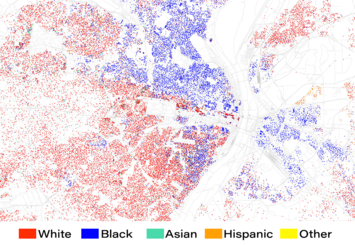
America’s downtowns, particularly those of the major cities at the heart of large metro regions of over one million people, have seen significant residential development and population growth in the recent years. Downtown Chicago, for example, has nearly 100,000 more residents than it did in the 1980s. Visit almost any downtown and see many nearly identical apartment buildings sprouting.
Many of these new residents are young, educated, and white, creating a narrative of a white return to the city. This return, often labeled gentrification, is frequently seen as a threat to lower income minorities in urban neighborhoods.
But while downtown and near-downtown neighborhoods across America are in fact seeing population growth, much of it white, outside of this fairly contained zone, white (non-Hispanic) population trends in the broader central areas turned negative during the course of the 2010s, as the housing market recovered from the Great Recession and enabled renewed outmigration to the suburbs.
This has been notable across Heartland urban regions. Recent Census ethnicity estimates at the county level reveal a significant shift from the earlier to the later part of the decade in most central counties.

The data values are total year over year white population change vs. the previous year. So the 2011 value is the total white population change between 7/1/2010 and 7/1/2011, and so on. The chart is sorted in decreasing order of total white percentage population change over the decade.
If you look at Franklin County, OH (Columbus), St. Louis (an independent city) Jefferson County, KY (Louisville), Marion County, IN (Indianapolis), you can see that they were gaining white population early in the decade but shifting to losing it later in the decade. Some of these counties posted solid overall population growth, which masked this underlying trend.
Among counties that grew white population throughout the decade, we also saw growth slowdowns in all of them. They were adding noticeably fewer white residents at the end of the decade than at the beginning. Jackson County, MO (Kansas City) is something of an exception.
Similarly, some of those counties showing persistent white population decline saw an acceleration in that trend over the course of the decade. But that was not true for all of these. Cuyahoga County, OH (Cleveland) had the highest white population loss, for example, but was pretty steady over the course of the decade.
People like William Frey of Brookings have been pointing out how urban population growth tailed off in the second half of the decade. This data suggests that a return of white flight may be a part of the reason why. Young, white, and educated people may be moving into downtowns, but the broader trend in white population in central county areas is turning negative.
Aaron M. Renn is a contributing editor at City Journal, and an economic development columnist for Governing magazine. He focuses on ways to help America’s cities thrive in an ever more complex, competitive, globalized, and diverse twenty-first century. During Renn’s 15-year career in management and technology consulting, he was a partner at Accenture and held several technology strategy roles and directed multimillion-dollar global technology implementations.
Photo credit: Eric Fischer via Flickr under CC 2.0 License












